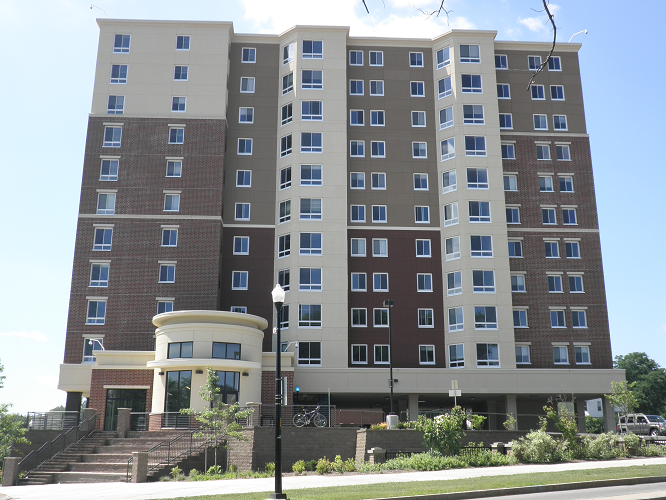
| River Campus | Brooks Crossing
Apartments |
 |
| Brooks Crossing Apartments |
Brooks Crossing is an apartment-style residence hall open to juniors and seniors. It was built and managed by a third-party developer and opened in 2014. The building is at the west end of the pedestrian bridge across the Genesee River.
The river level of the building includes a boathouse for the university's crew team and a rowing dry land training center.
Brooks Crossing is built
on the site of the early Castletown settlement. In 1800, James
Wadsworth built a tavern and store at the site and hired Isaac Castle to
manage them. Thereafter the community was officially known at Castletown,
but its location by the river gave it the more common, but less grandiose
nickname of “The Rapids.” Wadsworth’s belief in the viability of his
settlement was rooted in its location. With few roads in and out of the
settlement, aside from a few well-trodden Indian trails, most goods to
market had to travel the Genesee and then be transported by land to Lake
Ontario, where they could be shipped to other early New York settlements
or across the lake to Canada. Wadsworth envisioned Castletown as an ideal
fording point from the river to land, bypassing the High, Middle and Lower
Falls between the settlement and Lake Ontario.
In its initial decades, “The Rapids” was a transportation hub, with grain,
pork, lumber, barrel staves, flour and other goods passing through the
community. Shortly after the tavern and store were established, a church,
a school and several houses were built, but the growth of the community
would be short-lived. In 1822, a feeder canal (located at the
present site of the Brooks Avenue bridge) was built to supply Genesee
River water to the new Erie Canal. Because of the feeder, boats no longer
had to unload at Castletown. They turned off the river and poled up the
feeder to the main canal at Rochester (where Mount Hope and South Avenues
converge).
The Brooks Landing
building sits on the former Genesee
Valley Canal, which operated from 1838 to 1878, and the Genesee
Valley Canal Railroad, which later became part of the Pennsylvania
Railroad and operated from 1882 until to the early 1970s, but the
tracks were not removed until 1984.
References
1992 "At
the Rapids on the Genesee Settlement at Castletown," by Ruth
Rosenberg-Naparsteck, Rochester History 54(3):1-24 (Summer, 1992)
2013 Groundbreaking
Held for The Flats at Brooks Crossing, July 12, 2013.
The University of Rochester will be the main tenant of The Flats at Brooks
Crossing, a 12-story mixed-use project near the corner of Brooks Avenue
and Genesee Street in the Brooks Landing area. University President Joel
Seligman participated in the July 12 groundbreaking ceremony hosted by
Rochester City Mayor Thomas S. Richards, with the $18.7 million
development scheduled to be complete by fall 2014.
The Flats at Brooks Crossing is slated to feature 10 floors of housing
accommodating 170 University students in approximately 70 units; a 2,000
square-foot common area; a lower-level scull boat house; a 5,000
square-foot restaurant on the first floor of the building; and a second,
4,000 square-foot, single-story building on Genesee Street.
The 19th Ward and Plymouth-Exchange neighborhood associations, along with
the Sector 4 Community Development Corporation, have been very involved
with the Brooks Landing planning process over the past 25 years and joined
in the groundbreaking ceremony for the Flats at Brooks Crossing. Other
participants included developer Ron Christenson, president of Christenson
Corporation; City Council President Lovely A. Warren and council members
Dana Miller and Loretta Scott; and Monroe County Executive Maggie Brooks.
© 2021 Morris A. Pierce